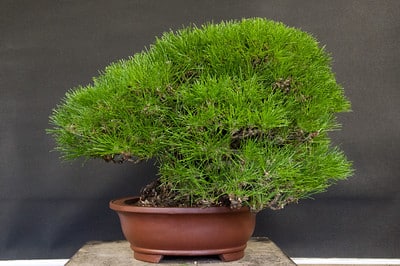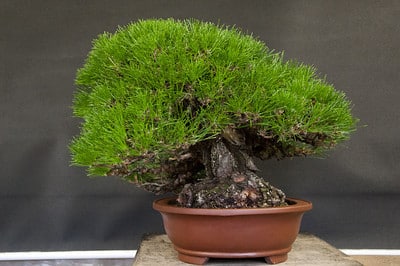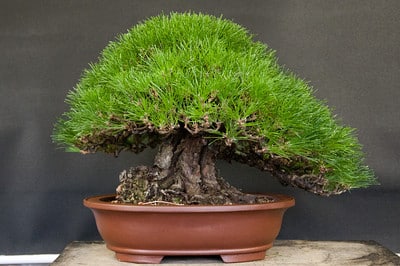The Japanese black pine below was one of the many great trees I saw in the workshop during my visit to Aichi-en last fall. I caught Peter Tea cleaning it up for the sales area at Gomangoku. You can see a before photo on Peter’s blog.
What made the tree stand out to me? The fullness, the health, and the density of shoots were impressive, and the bark and roots were also very good, but above all, I appreciated the silhouette of the tree. Solid blocks of foliage can do a great job defining a tree’s character.
Good balance between the left and right sides of the tree, a clearly defined key branch – the lowest branch on the left – and a window in the foliage that reveals the trunk are all conventional markers of good pine bonsai.

Japanese black pine – front
When we look at the tree from the side, we can see that it “leans” strongly forward. Put another way, the apex lies in front of the center of the pot by a significant margin. This feature is common among pines in Central Japan, but I don’t see it as much on pines, or other trees for that matter, in Northern California.

Right side

Left side
The foliage in the back of the tree was solid and dense.

Back
Despite the tree’s beauty in this state, it was only intended to look this good for a short time. Normally, far more needles are removed in winter. Last I heard, the tree sold at the show but remains in the care of Aichi-en where it will continue to develop.
Bay Island Bonsai’s 13th Annual Exhibit!
If you are planning to be in Northern California this weekend, I strongly encourage you to head over to Bay Island Bonsai’s 13th Annual Exhibit at the Lakeside Garden Center in Oakland, CA. The event promises to be a good time. It’s our first exhibit in the location and we’re really looking forward to it – come join us!
Subscribe to Bonsai Tonight
New Posts Delivered Every Tuesday and Friday
Cirilo Domine says
This might be related to the forward movement of trees in Japan that you’ve noticed. When I was in Kyoto, I took ikebana classes and one of the very first lessons is that flowers should face the person as if they are bowing or leaning forward. The ikebana sensei said that flowers should never turn away or face backward for that is considered rude or inconsiderate. It makes a whole lot of sense since the in the tokonoma,j the presentation is frontal-oriented and not in the round. This forward motion gives the arrangement more depth and presence to engage the viewer. It might be related to bonsai presentation as well.
Jeremiah Lee says
Beautiful Pine, So Dense!!!! See you at the show this weekend.